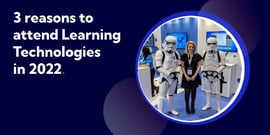What We Can Learn About Automation from Technology Leaders

We may only be one month into the year, but already ‘AI’ and ‘machine learning’ are fast becoming the buzzwords of 2017. And with good reason, since automated technologies are already revolutionising almost every aspect of our lives; at home, at work, at play…
Key takeaways:
- How Elon Musk believes automation will change the global economy
- Why Microsoft’s 6 ‘laws of AI’ are designed to aid the workforce
- What percentage of job-related tasks could be automated today
You name it, automated technology and artificial intelligence probably exists for it, from Google’s self-driving cars to manufacturing human organs. It’s been a bumpy road (literally, for Google’s project), but we’re now starting to see automation become a part of our daily lives. Think Amazon’s Alexa and Microsoft’s Cortana. Think language translators. Think the Internet of Things.
So what do tech leaders think about the current trend towards automation? How do they – and how will we – see the world developing, thanks to this disruptive technology?
Whenever someone says the word ‘automation’, there seems to be a flicker of doubt from employees. Automation equals job losses, so runs the thinking. Coursera founder Andrew Ng, who builds artificial intelligence systems and understands the intimacies of automation, has concerns about the short-term effects of smart machines, in which workers in all fields are displaced ‘much faster than even industrialization displaced agricultural workers or automation displaced factory workers.’
And employment is certainly something that occupies the thoughts of entrepreneur Elon Musk, who last year suggested that rampaging automation will inevitably lead to job losses – and change the way our economy currently works. He told CNBC:
"There is a pretty good chance we end up with a universal basic income, or something like that, due to automation. Yeah, I am not sure what else one would do. I think that is what would happen."
It’s not quite as dispiriting as first it seems; it’s not a vision of a Logan’s Run world where we all sit around being paid to do nothing, while letting computers take care of us. Indeed, Musk – who co-founded automated online payment service Paypal – seems fairly optimistic about an automated future, using truck-driving as an area of potential change. A fleet of self-driving trucks would have to be serviced, remotely, via a fleet operator. Musk suggests that, ‘actually, it's probably a more interesting job than just driving one.’
The sentiments of Musk perfectly jive with a recent conference interview from Microsoft CEO Satya Nadella, who highlighted the true benefits of artificial intelligence – one designed not to monger scares but to embrace the inevitable future with a positive outlook. In a statement that I (and the accessplanit team as a whole) can get behind, Nadella stated that:
"The fundamental need of every person is to be able to use their time more effectively, not to say, 'let us replace you'."
Microsoft’s goal, then, is to create ‘responsible AI’; AI that complements current roles, and opens up a whole field of new jobs in the same way industrialisation did over a century ago. In order to meet that objective, much like Asimov’s Three Laws of Robotics, Nadella has proposed the six basic ‘laws’ governing AI:
- A.I. must be designed to assist humanity
- A.I. must be transparent
- A.I. must maximize efficiencies without destroying the dignity of people
- A.I. must be designed for intelligent privacy
- A.I. must have algorithmic accountability so that humans can undo unintended harm
- A.I. must guard against bias
This line of thinking is mirrored by Google’s own AI safety rules – ensuring automated technologies have a positive impact on the people who use them.
All of this is ably supported by a recent report from management consultancy firm McKinsey & Co., who have suggested that wide-scale automation has the potential to not only maintain, but actually increase, overall employment:
"Even when machines do take over some human activities in an occupation, this does not necessarily spell the end of the jobs in that line of work. On the contrary, their number at times increases in occupations that have been partly automated, because overall demand for their remaining activities has continued to grow. For example, the large-scale deployment of bar-code scanners and associated point-of-sale systems in the United States in the 1980s reduced labor costs per store by an estimated 4.5 percent and the cost of the groceries consumers bought by 1.4 percent. It also enabled a number of innovations, including increased promotions. But cashiers were still needed; in fact, their employment grew at an average rate of more than 2 percent between 1980 and 2013."
McKinsey & Co.'s findings show that 51% of activities in the economy – that is, tasks, rather than jobs – could be automated. According to McKinsey, ‘about 60 percent of all occupations could see 30 percent or more of their constituent activities automated, again with technologies available today.’ We’re talking about those painfully mind-numbing and predictable activities, like administration, which machines are adept at undertaking, and which cost companies $2.7 trillion dollars in wages in the US alone.
And that’s before we even discuss the amount of time spent on these tasks. Thanks to our own industry insights, we know that in the training world alone, professionals can save 50% training admin time using automated technologies. Now apply that to every sector, every industry.
Suddenly the business benefits of automation come into sharp focus. On the cusp of new and exciting advances in technology, we’re discovering new ways to learn and develop both ourselves and our organisations – whether it’s automating your marketing communications, processing payments, offering globally translated services or even self-learning AI personal assistants.
All new technologies have associated scare stories: The spinning jenny, the telephone, the automobile, the internet were all considered dangerous frivolities by contemporary figures, and AI is no different (think Terminator 2: Judgement Day).
In every case, however, those technologies enabled us to rapidly become more productive, more engaged and more likely to use our time effectively. That’s exactly what automation and, in future, advanced AI offer us now.
Other resources that may interest you:


-1.jpg?width=270&height=170&name=New%20Project%20(23)-1.jpg)
